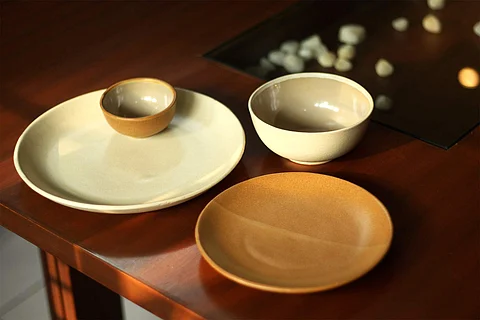

Mining of natural resources for creating consumer products takes a toll on the environment. But what if it could be reduced and valuable products can be made by absorbing a part of the waste material in the production process? That's what Shashank Nimkar from the National Institute of Design (Ahmedabad) is doing — for which he was recently awarded the James Dyson India Award 2020. Shashank's invention Earth Tatva, which is also the name of his start-up, uses a universal material by recycling post-industrial fired ceramic waste to create new, eco-friendly tableware. These brand new products are not only created out of industrial waste, but they are also manufactured through a completely zero-waste process.
Shashank tells us how it can also be recycled multiple times. The ceramic rejects are called 'grog' which he used to create new products. "I developed a universal material from grog, which can be reused for multiple production cycles, with this we can make any kind of products as it can be cast into any shape. We started with tableware as they are a group of product which consumers tend to buy quite often and thus it would help raise awareness among the masses. It will stir up discussions about a conscious lifestyle and what eco-friendly substitutes are available in the market for regular use," he says.
Explaining how it will eventually reduce mining, Shashank adds, "With Earth Tatva's composition, we use around 60 per cent of post-industrial ceramic reject as our raw material. We don't have to mine for more natural resources as we are reusing the reject. Because we use clay itself as a natural binder, clay after firing turns to ceramic, so we are actually working with a mono-material, which helps us to recycle this for multiple production cycles. In case, we have rejected waste material in our process, we can again reuse that as raw material. That's how the need for mining is reduced."
This production design has won him prize money of £2,000 (approximately 1.90 lakh) in the competition. "It's actually a great validation. My first reaction was just to absorb it as it was completely unexpected. I was hoping for it but didn't believe I could win it. It was announced in September this year," an ecstatic Shashank recalls. Shashank, who just completed his Masters in Industrial Design, specialising in ceramic and glass design, believes in the concept of a circular economy. "Ceramics don't biodegrade for centuries, industries today are facing this difficulty of what to do with their waste, hundreds and thousand tons of such rejects are still there in landfills for the past multiple decades. Now, at Earth Tatva we procure this from the landfills, turn them into a valuable resource, making it into a universal material and then create products. Thus, this turns a close looped linear process into a circular process," he explains.
Shashank first came up with the idea of Earth Tatva during his graduation project. "For the project, we visited Khurjah, a major ceramic production hub in India, one year before we finally began working on Earth Tatva. There I saw a lot of ceramic production rejects thrown away outside the factory, roadside. We thought something needs to be done about this. Since an early age, I have been inclined towards the idea of reusing waste and creating things of value from that. So, I took this up as my graduation project and then eventually began making products," he adds.
Currently, their products include a range of tableware, which are functional and used by customers on a daily basis. Shashank believes these products are capable of starting a conversation at the dining table, raise awareness and people would be interested in listening to the stories behind its creation. Shashank wants to collaborate with different brands in the near future, who can then use their material — to create their own line of products. "It will be made available to consumers thus providing them with products leaving behind a lower carbon footprint," he concludes.
